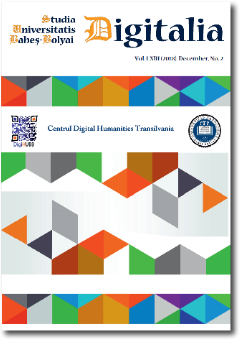THE USE OF RELATIONAL DATABASES IN EPIGRAPHY: A CASE STUDY
DOI:
https://doi.org/10.24193/subbdigitalia.2018.2.02Keywords:
epigraphy, inscriptions, database, open sourceAbstract
The study of an abundant number of inscriptions leads to the conception of schemas and forms that can be organized into databases. This procedure allows us to arrange information with precision and to draw data and create connections between them in quickly and easily. For this reason, the relational database model has proved to be a valid support, as it makes possible to arrange data and information logically according to pre-established constraints and relationships, reducing errors and repetitions. The aim of this paper is to present an example of the use of a relational database created to catalogue inscriptions and highlight the positive aspects and difficulties found out during the process. The complexity of this method is mostly related to making choices about entities and identifying relationships between them; another obstacle is connected to the complexity of inscriptions as group of words and formulae. Nevertheless, the relational database allows the researcher to mix up data and information and create new relationships between them using SQL operators. The software used for the case study that will be presented in this paper is an open source administration and development platform pgAdmin (for PostgreSQL).
References
Anichini, Francesca; Fabiani, Fabio; Gattiglia, Gabriele, Gualandi Maria Letizia, “Un database per la registrazione e l’analisi dei dati archeologici”, in MapPapers 1 – II, 2012, 1-20.
Anichini, Francesca and Paribeni Emanuela, “Il Gis archeologico della città di Pisa. Primi risultati per la tutela e la gestione del patrimonio archeologico pisano” Notiziario della Soprintendenza archeologica della Toscana, 1, 2005, 205-210.
Di Stefano Manzella, Ivan. Il mestiere di epigrafista: guida alla schedatura del materiale epigrafico lapideo. Quasar, Roma 1987.
Fronza, Vittorio, “Il Sistema di gestione degli archivi nello scavo di Poggio Imperiale a Poggibonsi. Una soluzione all’interno della soluzione GIS”, Archeologia e Calcolatori, 11, 2000, 125-137.
Fronza, Vittorio, “Principi di database management in archeologia: l’esperienza senese” III Congresso Nazionale di Archeologia Medievale edited by Fiorillo R., Peduto P., All’insegna del Giglio, Firenze, 2003, 629 – 632.
Fronza, Vittorio “L’archiviazione del dato in archeologia”, Informatica e Archeologia Medievale. L’esperienza Senese edited by in Fronza V, Nardini A., Valenti M., All’insegna del Giglio, Firenze, 2009, 1-15.
Laes, Christian. Children in the Roman Empire. Outsiders Within, Cambridge University Press, Cambridge 2011.
Mosca, Edoardo. Le epigrafi del Museo di Storia e d’Arte di Bra, SASTE, Bra, 1957.
Neraudau, Jean-Pierre. Etre enfant à Rome, coll. Realia, Les Belle Lettres, Paris, 1994.
Raepsaet-Charlier Marie-Therese. Hic situs est ou Dis Manibus. Du bon usage de la prodence dans la datation des épitaphes gallo-romaines in L’antiquité classique, vol. 71, 2002, 221-227.
Inscriptions Cited
Scheda EDR140804 by C. Scaletta (11/14/2015) = CIL V 2417 = CLE 1157 (Found in Ferrara, dated in the half I c. A.D.)
Scheda EDR134214 by V. Zovic (10/12/2013) = CIL V, 8195 (Found in Visinada/Vizinada, date unknown)
Scheda EDR139094 by M. A. Novillo Lopez (18/08/2014) = Brusin 1993, nr. 3214 (Found in Aquileia, IV c. A.D.)
Scheda EDR139687 by M.A. Novillo Lopez (22/07/2014) = ILCV 847 (Found in Aquileia, IV c. A.D.)
Scheda EDR146314 by C. Girardi /11/01/2015) = CIL V, 3172 (Found in Vicenza, date unknown)
Scheda EDR124801 by S. Zoia (23/02/2015) (Found in Milan, III- IV c. A.D.)
Scheda EDR081081 by L. Lastrico (24/09/2007) = CIL V, 7604 = ILS 6749 (Found in Alba, II c. A.D.)
CIL V, 8450 = EDCS01601269 = Ubi Erat Lupa nr. 16123 (Found in Aquileia, date unknown)
Downloads
Published
How to Cite
Issue
Section
License
Copyright (c) 2018 Studia Universitatis Babeș-Bolyai Digitalia

This work is licensed under a Creative Commons Attribution-NonCommercial-NoDerivatives 4.0 International License.


